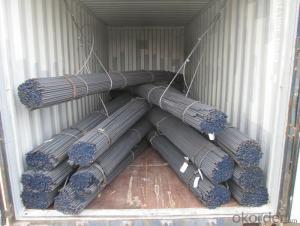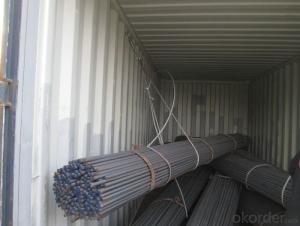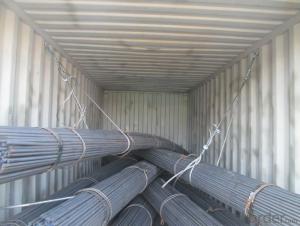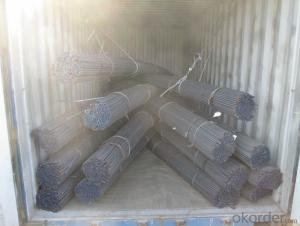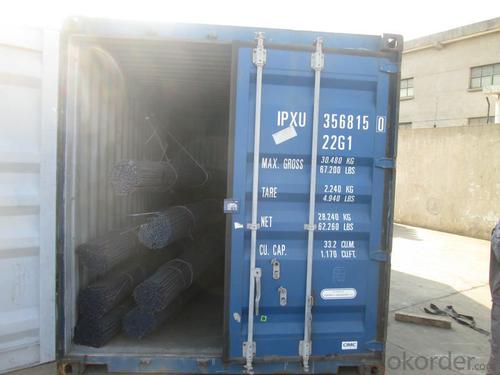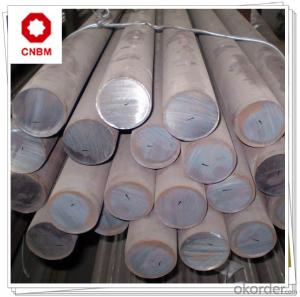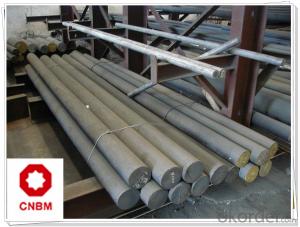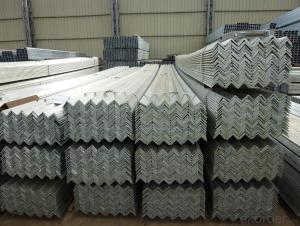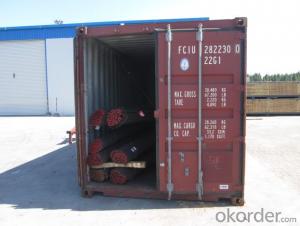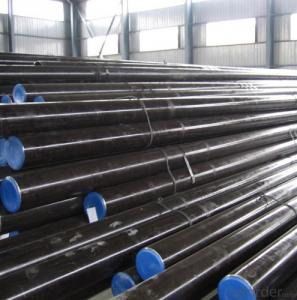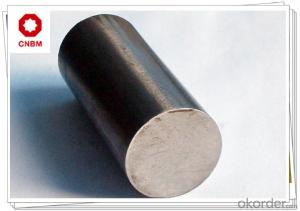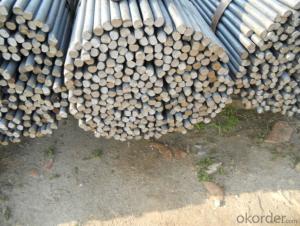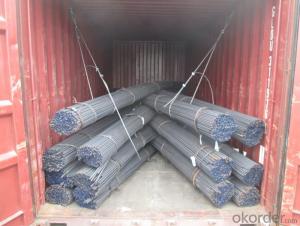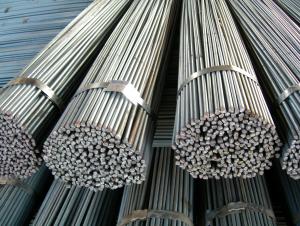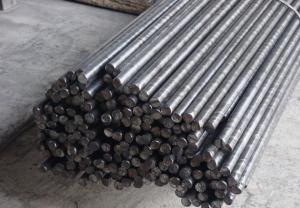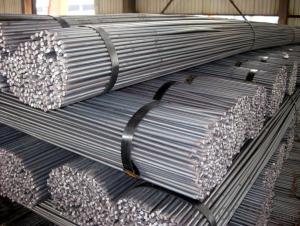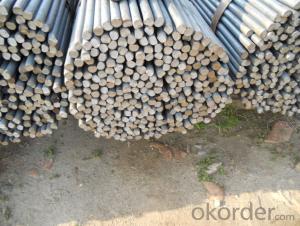Common Steel Round Bar SS400 Product with high quality
- Loading Port:
- Tianjin
- Payment Terms:
- TT or LC
- Min Order Qty:
- 25 m.t.
- Supply Capability:
- 7000 m.t./month
OKorder Service Pledge
OKorder Financial Service
You Might Also Like
OKorder is offering Common Steel Round Bar SS400 Product with high quality with worldwide shipping. Our supplier is a world-class manufacturer of steel, with our products utilized the world over. OKorder annually supplies products to European, North American and Asian markets. We provide quotations within 24 hours of receiving an inquiry and guarantee competitive prices.
Product Applications:
Common Steel Round Bar SS400 Product with high quality are ideal for structural applications and are widely used in the construction of buildings and bridges, and the manufacturing, petrochemical, and transportation industries.
Product Advantages:
OKorder's Common Steel Round Bar SS400 Product with high quality are durable, strong, and resist corrosion.
Main Product Features:
· Premium quality
· Prompt delivery & seaworthy packing (30 days after receiving deposit)
· Corrosion resistance
· Can be recycled and reused
· Mill test certification
· Professional Service
· Competitive pricing
Product Description:
Specifications of Common Steel Round Bar
1. Grade: 304, 316L, 321
2. Type: Mild carbon steel
3. Shape: Round bar, solid bar of steel with circular section
4. Diameter: 8mm-150mm
5. HS Code: 72283010
Usage and Applications of Common Steel Round Bar
1. Common Steel Round Bar of 8-25mm, or small round is mostly used for straight bundles supply, and used for steel, bolts and various mechanical parts. While the bigger round bar, or more than 25mm hot rolled bar, is mainly for the manufacture of mechanical parts or for seamless steel billet.
2. Steel round bar is used in construction and a large number of architectural and engineering structures.
3. Besides, we can supply some especial material steel round bar that can be used for main shaft of steamer, hummer shank, with big section and supper force.
Packaging & Delivery of Common Steel Round Bar
Packaging Detail: All goods are packed in bundle with steel strips and shipped by break bulk vessel or container (depend on target market and different ports)
Delivery Detail: 45 days
Trade terms: FOB, CFR, CIF
MOQ: 25 tons per specification; we can negotiate the quantity if the specification is normal or we have stock of one specification.
Weight: The price invoicing on theoretical weight basis or actual weight basis depends on customer’s request.
Shipment: The shipment of bulk break or container is depends on customer’s request and the situation of the port of destination.
Documents given: Full set of original clean on board bill of lading; Original signed commercial invoice; Original packing list; Policy of insurance; Certificate of origin and what the target market needs.
Production Flow of Common Steel Round Bar
We use advanced equipments like Electric Arc Furnace, Ladle Furnace and Vacuum Degasser to produce our products.
Material prepare (billet) — heat up — rough rolling — precision rolling — cooling — packing — storage and transportation
Characteristics of Common Steel Round Bar
1. The steel in which the main interstitial alloying constituent is carbon in the range of 0.12–2.0%.
2. As the carbon percentage content rises, steel has the ability to become harder and stronger through heat treating; however it becomes less ductile.
3. Quality should be in conformity with the specification of the manufacturer. Quantity and packing conditions should be in conformity with the term in the contract.
4. Regardless of the heat treatment, higher carbon content reduces weld ability. In carbon steels, the higher carbon content lowers the melting point.
FAQ:
Q1: Why buy Materials & Equipment from OKorder.com?
A1: All products offered byOKorder.com are carefully selected from China's most reliable manufacturing enterprises. Through its ISO certifications, OKorder.com adheres to the highest standards and a commitment to supply chain safety and customer satisfaction.
Q2: How do we guarantee the quality of our products?
A2: We have established an advanced quality management system which conducts strict quality tests at every step, from raw materials to the final product. At the same time, we provide extensive follow-up service assurances as required.
Q3: How soon can we receive the product after purchase?
A3: Within three days of placing an order, we will begin production. The specific shipping date is dependent upon international and government factors, but is typically 7 to 10 workdays.
Images:
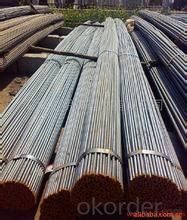
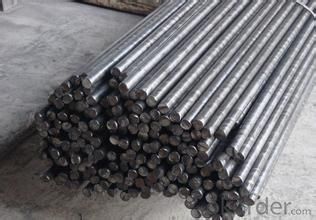
- Q: What are the different joining methods for steel round bars?
- Different grammar and expressions: 1. Steel round bars can be joined in various ways, depending on the specific application and desired outcome. Welding, brazing, and mechanical joining are among the most common methods used for joining steel round bars. 2. Welding is a widely used technique for joining steel round bars. It involves melting the edges of the bars and fusing them together using heat. The choice of welding technique, such as arc welding, MIG welding, TIG welding, or spot welding, depends on the thickness and type of steel being joined. Welding creates a strong and permanent bond, making it suitable for heavy-duty applications. 3. Brazing is another method employed to join steel round bars. In this process, the bars are heated and a filler metal with a lower melting point than the steel is melted. The molten filler metal is then drawn into the joint by capillary action, resulting in a strong bond when it solidifies. Brazing is often preferred when the base metals have different melting points or when a lower-temperature joining process is required. 4. Mechanical joining techniques, on the other hand, do not involve any heat or melting of the steel round bars. Instead, they rely on mechanical means to hold the bars together. Examples of mechanical joining methods include bolted connections, riveting, and clamping. These techniques are typically used when disassembly or adjustability is necessary, as they provide a non-permanent joint that can be easily undone. When selecting a joining method for steel round bars, it is crucial to consider factors such as strength requirements, environmental conditions, and the specific application. Each method has its own advantages and limitations, and the most appropriate joining method should be chosen to ensure a secure and durable bond between the round bars.
- Q: What is the difference between a hot-rolled and a forged steel round bar?
- The main difference between a hot-rolled and a forged steel round bar lies in the manufacturing process and the resulting properties of the finished product. Hot-rolled steel round bars are produced by heating a billet or ingot of steel to a high temperature and then shaping it into the desired form using rollers. This process allows for a high volume of production and a wide range of sizes and shapes. As the steel is heated and shaped, it undergoes significant deformation and recrystallization, resulting in a uniform grain structure. Hot-rolled steel round bars have a rougher surface finish and can have varying levels of internal stress due to the cooling process. They are commonly used in applications where strength and cost-effectiveness are important, such as construction, manufacturing, and general fabrication. On the other hand, forged steel round bars are produced by applying extreme pressure to a heated billet or ingot of steel, typically using a hammer or a press. This process creates a much stronger and more durable product compared to hot-rolled steel. The intense pressure applied during forging aligns the steel's grain structure, resulting in improved mechanical properties such as increased strength, toughness, and resistance to fatigue and impact. Additionally, the forging process eliminates internal voids and porosity, making forged steel round bars more reliable and less prone to failure. Due to the high level of customization and precision involved in forging, these round bars are often used in critical applications that require superior strength and performance, such as aerospace, automotive, and oil and gas industries. In summary, the main differences between hot-rolled and forged steel round bars lie in their manufacturing processes and resulting properties. Hot-rolled steel offers cost-effectiveness and a wide range of sizes and shapes, while forged steel provides superior strength, durability, and reliability. The choice between the two depends on the specific application and the desired performance characteristics.
- Q: What are the advantages of using maraging steel round bars?
- Using maraging steel round bars in various applications offers several benefits. Firstly, these bars possess an impressive strength-to-weight ratio, making them ideal for situations where strength is crucial. They can withstand high stress and load-bearing conditions without deforming or failing, ensuring structural integrity. Secondly, maraging steel round bars exhibit exceptional toughness, enabling them to absorb significant amounts of energy before fracturing. This toughness makes them highly resistant to cracking or breaking, even under extreme conditions, enhancing their durability and reliability. Additionally, maraging steel round bars are known for their outstanding corrosion resistance. Unlike other types of steel, they are less prone to rust and oxidation, making them suitable for use in harsh environments or where exposure to moisture or chemicals is a concern. This corrosion resistance helps extend the lifespan of the bars and reduces maintenance costs. Furthermore, maraging steel round bars are relatively easy to machine, despite their high strength and hardness. They can be easily shaped, drilled, and cut into different forms and sizes, allowing for versatile applications across various industries. This ease of machining saves time and effort during the manufacturing process. Moreover, maraging steel round bars have excellent heat treatability, meaning they can be hardened and tempered to further enhance their mechanical properties. This flexibility in heat treatment allows for customization to meet specific project requirements, such as achieving desired hardness levels or improving characteristics like wear resistance or toughness. Lastly, maraging steel round bars are widely used in the aerospace and defense industries due to their exceptional strength, toughness, and corrosion resistance. They are commonly utilized in the manufacturing of critical components such as landing gear, missile casings, and aircraft structures, where reliability and performance are paramount. In conclusion, the advantages of using maraging steel round bars include high strength, superior toughness, corrosion resistance, machinability, heat treatability, and suitability for aerospace and defense applications. These properties make them the preferred choice for demanding industries, ensuring optimal performance and longevity in critical applications.
- Q: Are steel round bars available in different shapes other than round?
- No, steel round bars are specifically designed and manufactured in a cylindrical shape.
- Q: What are the limitations of steel round bars?
- There are several limitations associated with steel round bars, which are important to consider when selecting the appropriate material for a particular application. 1. Weight: Steel round bars can be quite heavy, especially in larger diameters. This can pose challenges when it comes to transportation and installation, particularly in situations where weight restrictions are a concern. 2. Corrosion: While steel is generally known for its strength and durability, it is susceptible to corrosion. When exposed to moisture or certain chemicals, steel round bars can rust and deteriorate over time. This limitation can be mitigated through the use of protective coatings or by opting for stainless steel round bars, which are more resistant to corrosion. 3. Machinability: Steel round bars can be difficult to machine due to their high hardness and strength. This can result in increased tool wear and reduced cutting speeds, leading to higher production costs and longer machining times. 4. Cost: Steel round bars, particularly those made from high-quality alloys, can be relatively expensive compared to other materials. This cost factor may limit their use in certain applications where budget constraints are a concern. 5. Design Flexibility: Steel round bars come in standard sizes and shapes, which may restrict design flexibility in some cases. If a specific shape or size is required, additional processing steps such as cutting or forging may be necessary, adding to the overall production cost. 6. Fatigue Strength: Although steel round bars have excellent strength properties, they can be prone to fatigue failure when subjected to repeated or cyclic loading. This limitation is particularly relevant in applications where the material is subjected to constant stress or vibration. Despite these limitations, steel round bars remain a popular choice in various industries due to their exceptional strength, reliability, and versatility. However, it is essential to consider these factors to ensure that the chosen material meets the specific requirements of the intended application.
- Q: What is the tensile strength of a steel round bar?
- The tensile strength of a steel round bar depends on various factors such as the specific grade of steel, the manufacturing process, and any additional treatments or coatings applied. Generally, steel round bars have high tensile strength due to their composition and structural design. The specific tensile strength can vary significantly depending on the grade of steel. For example, low carbon steel typically has a tensile strength of around 400-550 MPa (megapascals), while high carbon steel can have a tensile strength of 700-1000 MPa or even higher. It's worth noting that the tensile strength of a steel round bar can be further enhanced by heat treatment processes such as quenching and tempering, which can significantly increase its strength and hardness. Additionally, certain alloying elements like chromium, nickel, and molybdenum can be added to steel to improve its tensile strength and other mechanical properties. To determine the exact tensile strength of a specific steel round bar, it is crucial to refer to the manufacturer's specifications or consult relevant industry standards such as ASTM (American Society for Testing and Materials) or AISI (American Iron and Steel Institute) standards. These standards provide detailed information on the mechanical properties, including tensile strength, for various grades of steel.
- Q: What is the weight of a steel round bar?
- The weight of a steel round bar is determined by its dimensions, specifically its diameter and length. You can determine the weight using the formula: weight = volume × density. To determine the volume of the steel round bar, you can use the formula for the volume of a cylinder: volume = π × (diameter/2)^2 × length. Here, π represents a mathematical constant approximately equal to 3.14159. The density of steel varies depending on the type and grade, but it typically falls around 7.85 grams per cubic centimeter (g/cm³) or 7850 kilograms per cubic meter (kg/m³). By substituting the appropriate values into the formula, you can calculate the weight of the steel round bar in the desired unit, such as grams, kilograms, pounds, and so on.
- Q: How do steel round bars compare to brass or copper bars?
- Steel round bars, when compared to brass or copper bars, exhibit several key differences. Firstly, steel bars are known for their superior strength and durability. They have a high tensile strength and are capable of withstanding heavy loads and impacts, making them ideal for applications that require robustness and toughness. On the other hand, brass and copper bars are relatively softer and less rigid, making them more suitable for applications that prioritize malleability and electrical conductivity. Another significant difference lies in their corrosion resistance. While brass and copper bars are known for their excellent corrosion resistance, steel bars, particularly carbon steel, are more vulnerable to rusting. However, stainless steel round bars are highly resistant to corrosion due to the presence of chromium, making them a suitable alternative to brass or copper bars in environments where corrosion is a concern. In terms of cost, steel round bars are generally more economical compared to brass or copper bars. This is primarily due to the higher availability and lower production costs associated with steel. Brass and copper, being non-ferrous metals, are less abundant and require more complex extraction and refining processes, making them relatively more expensive. Furthermore, steel round bars offer a wide range of mechanical properties, such as different grades and compositions, allowing for customization based on specific application requirements. Conversely, brass and copper bars have more limited options in terms of strength and hardness variations. Overall, the choice between steel, brass, or copper round bars depends on the specific application and desired properties. Steel bars are preferred for their strength, durability, and cost-effectiveness, while brass or copper bars are favored for their malleability, electrical conductivity, and corrosion resistance.
- Q: Can steel round bars be used in food processing industries?
- Yes, steel round bars can be used in food processing industries. Steel is a popular material choice for various applications in the food industry due to its durability, strength, and corrosion resistance. Steel round bars can be used in food processing equipment such as mixers, conveyors, grinders, and slicers. They can also be used in the fabrication of food storage containers, shelves, and racks. However, it is important to ensure that the steel used in food processing industries is of food-grade quality to meet the necessary hygiene and safety standards.
- Q: What are the advantages of using maraging steel round bars?
- Using maraging steel round bars in various applications offers several benefits. Firstly, these bars possess an impressive strength-to-weight ratio, making them ideal for situations where strength is crucial. They can withstand high stress and load-bearing conditions without deforming or failing, ensuring structural integrity. Secondly, maraging steel round bars exhibit exceptional toughness, enabling them to absorb significant amounts of energy before fracturing. This toughness makes them highly resistant to cracking or breaking, even under extreme conditions, enhancing their durability and reliability. Additionally, maraging steel round bars are known for their outstanding corrosion resistance. Unlike other types of steel, they are less prone to rust and oxidation, making them suitable for use in harsh environments or where exposure to moisture or chemicals is a concern. This corrosion resistance helps extend the lifespan of the bars and reduces maintenance costs. Furthermore, maraging steel round bars are relatively easy to machine, despite their high strength and hardness. They can be easily shaped, drilled, and cut into different forms and sizes, allowing for versatile applications across various industries. This ease of machining saves time and effort during the manufacturing process. Moreover, maraging steel round bars have excellent heat treatability, meaning they can be hardened and tempered to further enhance their mechanical properties. This flexibility in heat treatment allows for customization to meet specific project requirements, such as achieving desired hardness levels or improving characteristics like wear resistance or toughness. Lastly, maraging steel round bars are widely used in the aerospace and defense industries due to their exceptional strength, toughness, and corrosion resistance. They are commonly utilized in the manufacturing of critical components such as landing gear, missile casings, and aircraft structures, where reliability and performance are paramount. In conclusion, the advantages of using maraging steel round bars include high strength, superior toughness, corrosion resistance, machinability, heat treatability, and suitability for aerospace and defense applications. These properties make them the preferred choice for demanding industries, ensuring optimal performance and longevity in critical applications.
Send your message to us
Common Steel Round Bar SS400 Product with high quality
- Loading Port:
- Tianjin
- Payment Terms:
- TT or LC
- Min Order Qty:
- 25 m.t.
- Supply Capability:
- 7000 m.t./month
OKorder Service Pledge
OKorder Financial Service
Similar products
Hot products
Hot Searches
Related keywords

